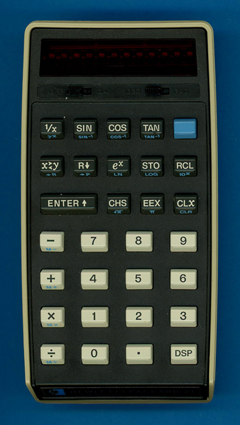
DATAMATH CALCULATOR MUSEUM
 |
DATAMATH CALCULATOR MUSEUM |
Hewlett-Packard HP-21
| Date of introduction: | February 1, 1975 | Display technology: | LED |
| New price: | $125 (MSRP February 1975) | Display size: | 8 + 2 |
| Size: | 5.1" x 2.7" x
1.2" 129 x 68 x 30 mm3 |
||
| Weight: | 5.8 ounces, 165 grams | Serial No: | 1508A09706 |
| Batteries: | HP-82019A/B (2*NiCd AA-size) | Date of manufacture: | wk 08 year 1975 |
| AC-Adapter: | HP-82024A | Origin of manufacture: | USA |
| Precision: | 10 | Integrated circuits: | |
| Logic: | RPN | ||
| Memories: | 1 | ||
| Program steps: | Courtesy of: | Ken H. Meine |

![]()

 Hewlett-Packard
introduced in January 1972 the World's first pocket sized electronic calculator
performing both logarithmic and trigonometric functions, simply named as Model
35 or HP-35 as reference to its number of keys. This HP-21 introduced in
February 1975 offered more functionality than the HP-35 in a smaller package for
less than one third of the cost price. Proof of both the effect of healthy
competition and Moore's Law. While Hewlett-Packard could enjoy their first-mover
advantage with the HP-35, it took exactly 2 years before Texas Instruments
introduced in January 1974 with the SR-50
their first Slide Rule calculator with superior performance but a selling price
of only $169.95 versus HP's original $395 price tag lowered in January 1975 to
$295.
Hewlett-Packard
introduced in January 1972 the World's first pocket sized electronic calculator
performing both logarithmic and trigonometric functions, simply named as Model
35 or HP-35 as reference to its number of keys. This HP-21 introduced in
February 1975 offered more functionality than the HP-35 in a smaller package for
less than one third of the cost price. Proof of both the effect of healthy
competition and Moore's Law. While Hewlett-Packard could enjoy their first-mover
advantage with the HP-35, it took exactly 2 years before Texas Instruments
introduced in January 1974 with the SR-50
their first Slide Rule calculator with superior performance but a selling price
of only $169.95 versus HP's original $395 price tag lowered in January 1975 to
$295.
 Hewlett-Packard went through a drastic cost-reduction program with the
HP-21 and reduced the number of batteries from 3 to 2, the number of digits of
the LED display from 15 to 12 and replacing three Read-Only Memories (ROMs) with
a capacity of 256*10 bits, each with one much higher integrated 1,024*10 bits
chip allowing an aggressive MSRP of $125. Here at the Datamath Calculator Museum
we consider the HP-21 the first member of Hewlett-Packard's "Second Generation
Handheld Calculators".
Hewlett-Packard went through a drastic cost-reduction program with the
HP-21 and reduced the number of batteries from 3 to 2, the number of digits of
the LED display from 15 to 12 and replacing three Read-Only Memories (ROMs) with
a capacity of 256*10 bits, each with one much higher integrated 1,024*10 bits
chip allowing an aggressive MSRP of $125. Here at the Datamath Calculator Museum
we consider the HP-21 the first member of Hewlett-Packard's "Second Generation
Handheld Calculators".
Starting a
Price War with Texas
Instruments, the company that
invented the Integrated Circuit? Not a great idea and TI picked up the
paddles for a long lasting ping pong match:
|
• January 1972: HP-35 ($395.00) • January 1974: SR-50 (169.95), HP-35 ($295.00) • January 1975: HP-35 ($195.00) • February 1975: HP-21 ($125.00) • March 1975: SR-50A ($109.50) • June 1976: SR-40 ($49.95) • May 1978: HP-31E ($60.00) |
Milestones of HP calculators
Hewlett-Packard (HP) introduced in 1968 the World's first desktop scientific calculator, the HP 9100A. The programmable calculator stores programs on magnetic cards and lets scientists perform complex calculations without the need to access much larger computers. It is 10 times faster than most machines at solving science and engineering problems. Advertisements for the 9100A call the device a "personal computer," one of the first documented uses of the term.
Only 4 years later, on January 4, 1972, HP makes another advance in personal computing with the HP-35, the World's first scientific handheld calculator. Small enough to fit into a shirt pocket, the powerful HP-35 makes the engineer's slide rule obsolete. With the HP-80 a similar business model was introduced in February 1, 1973. In May of 1973 the HP-45 followed before the first programmable model HP-65 was introduced in January 19, 1974 with a retail price of $795. The HP-70 was introduced in August 1974 to complement the HP-80 as lower end business calculator and it took another few months till the introduction of the HP-55 in January 1975, the last calculator in Hewlett-Packard's series of "First Generation Handheld Calculators". Early in the year 1975 the price tag of the HP-35 dropped to $195 and the calculator was discontinued soon after with the introduction of its successor HP-21, a member of the "Second Generation Handheld Calculators". The introduction of the HP-31E in May 1978 together with its siblings HP-33E and HP-38E marked with the "Third Generation of Handheld Calculators" the end of HP calculators with LED Displays before introducing the revolutionary HP-41C with its alphanumeric LC-Display in July 1979 and the everlasting HP-12C and its sibling HP-11C in September 1981.
In the year 1975 dozens of companies manufactured calculators with 4 functions and a selling price below $20, scientific and business calculators in the range around $100 and programmable calculators priced about $250. The slide rule was outdated and famous companies like Dennert & Pape (ARISTO), A.W. Faber-Castell and Keuffel & Esser stopped the production.
If you have additions to the above article please email: joerg@datamath.org.
© Joerg Woerner, December 3, 2023. No reprints without written permission.